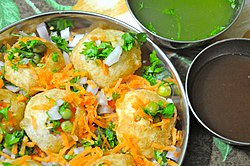Panipuri
 | |
| Alternative names | Paani patashi (Haryana) Pani ke batashe (Uttar Pradesh) Tikiya (Madhya Pradesh) Golgappa, gol gappay or gol gappa (Delhi, Punjab) Phuchka (Bihar, Jharkhand, Nepal, Bengal) Phuska/Puska (Assam) Fuska (Sylhet and Chittagong) Gup-chup (Odisha, Chhattisgarh) Pakodi (Gujarat) |
|---|---|
| Type | Snack |
| Place of origin | India |
| Main ingredients | Flour, spiced water, onions, potatoes, chickpeas |
Panipuri (ⓘ) or Phuchka (ⓘ) is a type of snack that originated in the Indian subcontinent.[1]
It consists of a round or ball-shaped, hollow puri (a deep-fried crisp crepe), filled with a mixture of flavored water (known as imli pani), tamarind chutney, chili, chaat masala, potato, onion or chickpeas.[2][3]
Names
Panipuri's name varies depending on the region. In Haryana it is known as paani patashi; in Madhya Pradesh fulki; in Uttar Pradesh pani ke batashe/padake ; in Assam phuska/puska and pakodi; in parts of Gujarat, Gup-chup in parts of Odisha, Phuchka in Bihar, Nepal, Jharkhand, Bengal and Chhattisgarh.[4]
Phuchka (or fuska or puska) differs from panipuri in content and taste. It uses a mixture of boiled gram and spiced mashed potatoes as the filling,[4] and is tangy rather than sweetish while the water is sour and spicy.
Gallery
See also
References
- ^ Tarla Dalal, Chaat Cookbook., Gardners Books, 2000, 116 p. ISBN 978-81-86469-62-0
- ^ Ramprasad, Gayathri (2014). Shadows in the Sun: Healing from Depression and Finding the Light Within. Hazelden. p. 260. ISBN 978-1-61649-531-2.
- ^ Pani Puri recipe in Veg Recipes of India
- ^ a b "11 Different Names For Your Favourite Pani Puri". indiatimes.com. Retrieved 12 June 2017.









